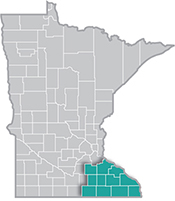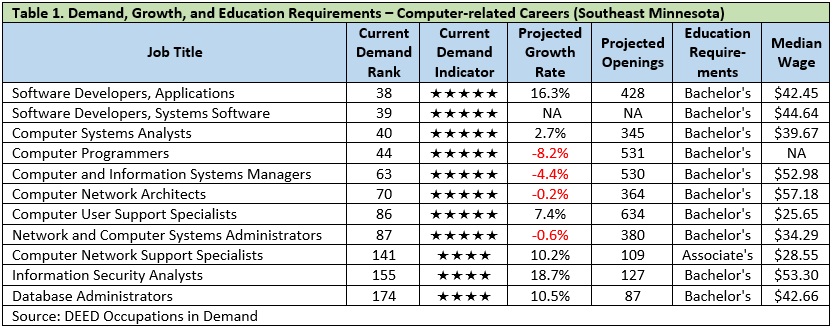 Southeast Minnesota is a health care and agricultural powerhouse. The region is home to the renowned Mayo Clinic and some of the world's most recognized food companies and brands.
Southeast Minnesota is a health care and agricultural powerhouse. The region is home to the renowned Mayo Clinic and some of the world's most recognized food companies and brands.
Advanced manufacturing is especially strong here, with machinery, chemicals, and electronics among the top products.
Want the freshest data delivered by email? Subscribe to our regional newsletters.
3/5/2019 4:00:00 PM
Besides being some of the higher paying occupations in the region, most computer-related jobs are in high demand in the Southeast region. As seen in Table 1, there are 11 computer occupations showing high demand, including four in the top 50 and eight in the top 100. Not all of these occupations are expected to see growth over the 2016 to 2026 projection period in DEED’s Employment Outlook tool, but they still show up as high demand in DEED’s Occupations in Demand tool.
Four of these computer occupations – computer programmers, computer and information systems managers, computer network architects, and network and computer systems administrators – are expected to see negative growth. However, due to the need to fill openings created by those who leave the labor force or transfer to other occupations, thousands of openings over this ten-year period are projected.

Computer-related careers are generally among the higher paying occupations, and the data certainly supports this. According to DEED’s Occupational Employment Statistics, median wages range from $25.65 for computer user support specialists to $53.30 for information security analysts. Put into perspective, current cost of living data show that an individual in the ‘typical family’ (a two-parent family with one child and one parent working full-time while the other works part-time, equaling a total of 60 hours per week) needs to earn an hourly wage of $15.81. A single person with one child would need to earn $21.88 per hour to meet the basic cost of living needs. Even the lowest paying occupation on the in-demand list earns well above these cost of living requirements.
Table 1 shows the typical education requirements needed for entry into these in-demand computer occupations; all but one, computer network support specialists, require a minimum of a bachelor’s degree. However, even with an associate degree there is room to move forward and upward in computer career pathways with further education and experience. For example, one may earn an associate degree and initially gain employment as a computer network support specialist. In time, they may earn a bachelor’s degree in computer science, subsequently opening doors to other computer occupations.
According to DEED’s Match Jobs to Experience data, computer systems analysts and information security analysts are matched well with computer network support specialists with the exception of requiring a bachelor’s degree – computer systems analysts showing as a 69 percent match and information security analysts showing as a 77 percent match. Both occupations offer successively higher median hourly wages, once an individual has earned a bachelor’s degree (Figure 1).

In Southeast Minnesota, not only are many computer occupations in high demand, the jobs pay well. The investment in earning post-secondary educational credentials certainly pays off in higher hourly wages and opens up possibilities for career changes and advancement.
Contact Mark Schultz.